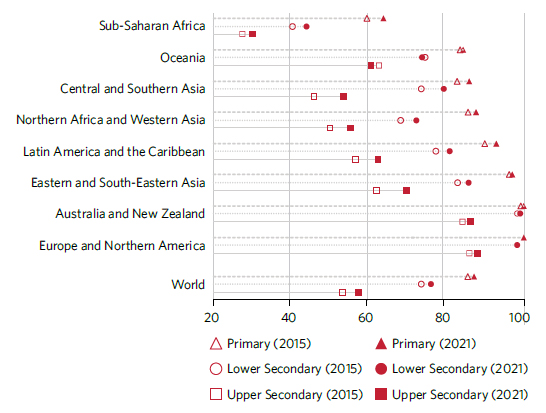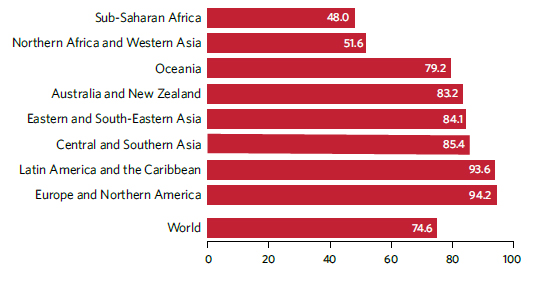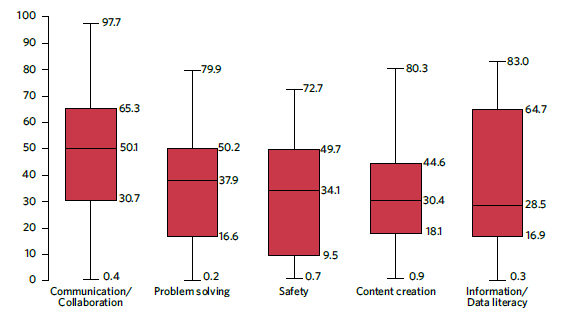Quality Education

Maria, 9, learns from pre-recorded lessons on her father’s phone at the Kili internally displaced persons camp in Syria. A distance-learning platform was designed to ensure education for displaced and refugee children.
© UNICEF/Ali Haj Suleimannational investment priority. Furthermore, measures such as making education free and compulsory, increasing the number of teachers, improving basic school infrastructure and embracing digital transformation are essential.
Primary and secondary school completion is rising, but the pace is far too slow and uneven
Between 2015 and 2021, worldwide primary school completion increased from 85 to 87 per cent, lower secondary completion rose from 74 to 77 per cent and upper secondary completion grew from 53 to 58 per cent. However, the pace of improvement was significantly slower than the 2000–2015 period. Most regions have primary completion rates of nearly 90 per cent or higher, except sub-Saharan Africa, where fewer than two-thirds of children complete primary school. In impoverished regions, poor learning outcomes lead to high drop-out rates and delayed completion. In sub-Saharan Africa, although 80 per cent of primary-aged children are enrolled in school, only 62 per cent graduate on time. Economic burdens, like expenses for books and uniforms, plus opportunity costs, also contribute to incomplete education.
Since 2019, UNESCO Member States have participated in a national Goal 4 benchmarking process to set national education targets. Despite the aspiration of universal secondary school completion, only one in six countries aims to achieve this goal by 2030 based on their national targets. Even if these targets are met, an estimated 84 million children and young people will still be out of school by 2030.
School completion rate, by level of education, 2015 and 2021 (percentage)

Patchy data show disappointing progress on improving primary school reading levels
In 2015, approximately 60 per cent of students demonstrated minimum proficiency in reading across primary and lower secondary schools. However, achieving universal minimum learning proficiency by 2030 requires an average annual improvement of around 2.7 percentage points. Despite positive gains between 2000 and 2019, progress was minimal and significantly slower than required. Examining reading levels at the end of primary school, trend data covering 34 per cent of the world’s children reveal an annual improvement of 0.39 percentage points, less than one seventh of what’s needed. However, comprehensive trend data to fully assess progress are lacking. Enhancing national and cross-national assessments is crucial for effective monitoring.
The pandemic has had devastating impacts on learning. Learning losses due to COVID-related school closures were documented in four in five of the 104 countries studied. A recent Progress in International Reading Literacy Study assessment revealed declines in 21 out of 32 countries with comparable data from 2016–2021, and parents reported also that two thirds of students experienced learning setbacks due to prolonged periods at home. Another study in seven high-income countries found COVID-19-related learning losses equivalent to 30 per cent of a school year for mathematics and 35 per cent for reading if schools were closed for eight weeks. According to national education targets, the percentage of students attaining basic reading skills by the end of primary school is projected to rise from 51 per cent in 2015 to 67 per cent by 2030. However, an estimated 300 million children and young people will still lack basic numeracy and literacy skills by 2030.
Access to early childhood education has expanded, but progress has slowed since 2015
Early schooling stimulates children’s readiness for school and improves their future learning experience. In 2020, three out of four children globally were enrolled in organized learning one year before the official primary entry age, with progress stagnating since 2015. The pandemic caused temporary dips in pre-primary education participation, with 30 out of 52 countries with data for 2021 or after witnessing declines. Only half of children were enrolled in organized learning one year before the official primary entry age in sub-Saharan Africa and in Northern Africa and Western Asia in 2020. The average attendance rate of early childhood education for children aged 36–59 months in 61 low- and middle-income countries was 37 per cent, with a 16-percentage-point gap between urban and rural areas and a 34-percentage-point gap between the richest and poorest quintiles. As of 2020, only half of the 187 countries and areas with data provided free pre-primary education, and almost three quarters of the 215 countries and areas with data did not make pre-primary education compulsory. Failure to eliminate school fees risks entrenching inequality. About 40 per cent of countries have not achieved gender parity.
Participation rate in organized learning (one year before the official primary entry age), 2020 (percentage)

Note: “Eastern and South-Eastern Asia” data are from 2019.
Low digital skills hamper progress towards universal and meaningful connectivity
Low levels of information and communications technology (ICT) skills are a major barrier to achieving universal and meaningful connectivity. Data on digital skills are limited, only available in 78 countries and rarely for all five categories of skills (communication/collaboration; problem-solving; safety; content creation; and information/data literacy). While 86 per cent of individuals use the Internet in countries providing data, many lack the required digital skills to be able to fully benefit from it or avoid its dangers. Communication/collaboration skills are the most prevalent, followed by problem-solving, safety and content creation. Information/data literacy varies widely between countries. Among 74 countries that provided data on at least three skills areas, only five reported averages of over 75 per cent in multiple areas.
Proportion of youth and adults with ICT skills, by type of skill, 2019–2021

Note: The bars indicate the 25th, median and 75th percentile of all country values. The bottom and top lines indicate the minimum and maximum values (excluding outliers).
Basic school infrastructure varies widely across regions and is far from universal
Access to basic school facilities is essential for safe and conducive learning environments, but one in four primary schools globally lacks basic services like electricity, water, sanitation and handwashing facilities. Access to computers, the Internet and disability-adapted facilities is even lower, with fewer than one in two primary schools having access, on average. Access is higher in lower and upper secondary schools. Regions with the lowest access to basic facilities include Central and Southern Asia, sub-Saharan Africa, and Latin America and the Caribbean. However, some progress has been made, with primary school electricity access increasing by over 10 percentage points since 2012. Access to computers and disability-adapted facilities, essential for marginalized students’ participation, has also improved by almost 5 percentage points.
Adequate infrastructure is also important for mitigating COVID-19 transmission and ensuring safe education. In early 2021, fewer than 10 per cent of low-income countries reported having sufficient soap, clean water, masks, and sanitation and hygiene facilities to assure the safety of all learners and staff, compared with 96 per cent in high-income countries. Investment and monitoring of infrastructure should be a policy priority to prevent the further entrenchment of inequalities.
Many teachers still lack the required qualifications to teach
Ensuring that all teachers possess the minimum qualifications required for their profession is crucial for achieving quality education. However, in 2020, more than 14 per cent of teachers were still not qualified according to national norms, with considerable disparities between countries and across regions. Sub-Saharan Africa faces the biggest challenge, with the lowest percentages of trained teachers in pre-primary (60 per cent), primary (69 per cent) and secondary education (61 per cent) among all regions. The COVID-19 pandemic severely disrupted education, affecting the teaching workforce in most countries. To maintain access, teachers had to adapt to new pedagogical concepts and methods, for which many were unprepared.

